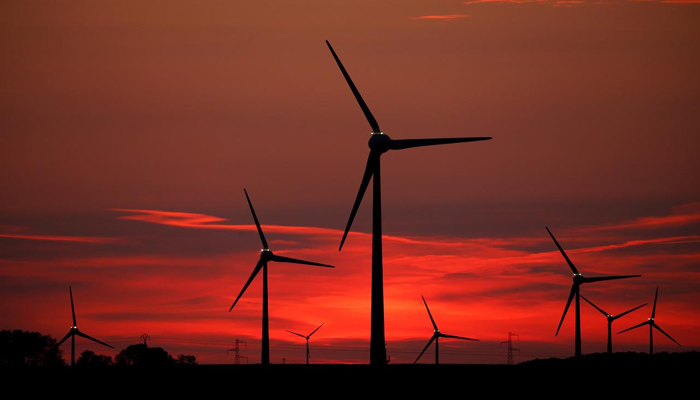Using wind and solar power to solve the energy crisis
By 2030, Pakistan will have around 60% market share of renewable energy sources about half of which will come out of solar and wind
November 01, 2021

By 2030, Pakistan will have around 60% market share of renewable energy sources about half of which will come out of solar and wind. This would bring a good change to the country’s overall energy scene, helping in solving the existing environment and climate issues and reducing energy imports.
However, there will be some problems as well. Almost all renewable sources, especially solar and wind, are intermittent — available either on a variable-hour basis or in higher frequency. Previously, during fossil fuel-dependent days, the persistent issue was demand variation while supply used to be mostly maintained at a constant level. Now with such a large share of varying renewable energy sources, maintaining grid stability would be a difficult job.
Transmission and an even distribution system will have to be improved. On the supply side, storage and hybridisation will have to be undertaken. Solar and wind energy resources can be installed on the same plot of land, increasing final output and utilising common ancillary and transmission facilities. 'Solar-wind' is a highly localised combination and may have varying output and capacity factors. A solar hybrid plant may be almost like a thermal power source but with some consistency and much less variability.
It would be the best of both worlds. Even solar and hydro can be combined; one form of which is floating hydropower plants on dams which reduces water loss through evaporation. There are examples of solar power plants floating on canals as well. Solar energy is available in abundance throughout Pakistan. However, wind energy is mostly limited in Sindh and Balochistan. While there are other renewable energy sources in Sindh, Balochistan has limited options and merits the installation of solar and hybrid power plants.
An important and probably most important finding of the World Bank (WB) study is that there are seven sites with solar-wind hybrid characteristics and which are interconnection ready zones. In total, these solar and wind hybrid sites can have a capacity of 1500 MW. These sites are at Qila Saifullah, Panjgur, Khuzdar, Much and Muslimbagh, all falling within the domain of the Quetta Electric Supply Company (Qesco). Only one solar-wind hybrid is in the Multan Electric Power Company (Mepco) region, in Rojhan.
From both demand and supply sides, Sindh is the most opportune province for installing solar-wind hybrid capacity. In Khyber Pakhtunkhwa (KP), only solar and hydro hybridisation is possible. In KP, wind resources have not been identified except in Chitral and D I Khan. In Chitral, solar, wind and hydro can be hybridised — a two- or three-source system.
The Asian Development Bank (ADB) has funded and set up a solar-wind hybrid plant in Khushab, Punjab, which is operating successfully. The plant derives 30 kW from solar and the remaining 20 kW from two wind turbines of 10 kW each. The hybrid pant provides around 50 kW to over 500 people in 80 households. This was the first and only plant installed in 2017.
Some recent reports suggest that a 400-MW solar-wind hybrid plant will be set up in Spain, by 2025. In one of the projects, a 40.9 MW of solar plant will be added to the 49.5 MW wind farm; another 14.5 MW wind farm will see the addition of 13.2 MW solar.
As reported recently, Engro has announced an MoU with the Sindh government for the installation of a 400-MW solar-wind hybrid power plant in Jhimpir to power industries located in the area of Dhabeji and Port Qasim industrial zones; expected commissioning is in 2024. Earlier, the company had decided to install a similar project in Balochistan. However, there hasn’t been any update in this regard.
The wind power capacity factor is 35-40%, and for solar, it is 20%. Their total sum, however, may be less than 55-60% for a variety of reasons. Storage may be able to add another 20% capacity factor. Recently, in India, a solar-hybrid tariff has been approved at INR 3.86 per kWh with a capacity factor of 80-85%. It is a two-part tariff providing separate rates for peak and 0ff-peak power. Normal solar-hybrid power plants implemented in India have a capacity factor of 40-50%. One would not be sure if wind power capacity factor numbers are lower in India.
The lowest solar-wind hybrid tariff offered in a recent auction (September 2021) in India has been INR2.34 per unit for project capacities of up to 150-450 MW. Earlier, hybrid tariff auctions were reported at INR2.41-2.69 per unit. By comparison, the lowest solar power tariff in December 2020 was INR1.99 per unit. Thus, it appears that hybrid may not be cheap despite purported advantages of savings in physical facilities. But are market and technology risks or is a loss of capacity utilisation in hybridisation the main reason for this high cost? We have noted above that even higher storage tariffs of INR3.85 – 5.21 US cents —per unit are higher.
It is strange that solar-wind hybrid plants have not been picked up much, not only in Pakistan, but elsewhere too. With the development of battery storage technologies, the potential has improved — perhaps only recently. In Pakistan, a policy vacuum has also contributed to a lack of progress in this regard. One may counter that even the capacity of individual solar- and wind-powered plants remained underdeveloped. However, the National Electronic Power Regulatory Authority (Nepra) has, in its report, emphasised the need of launching hybrid projects.
This leads to an important question: do we need a separate hybrid policy, or will policy provisions be enough? If competitive bidding is implemented, perhaps no other criterion other than the minimum producer tariff would be required. If it is not, it might be necessary to define some parameters and loss issues. Issues such as capacity factor, location and co-location, relative shares of solar and wind may require definition and clarification.
A lack of clarification may later introduce complications and cause delays in project approvals. Is the existing wind power plant eligible for hybridisation as it may perhaps be the easiest and cheapest way of expansion? Or is a new site eligible for a new hybrid project? Can we use the same plot for additional projects, or do we need separate plots that are at some distance? Location priorities are often specified in plans like the Indicative Generation Capacity Expansion Plan (IGCEP). However, the latter has not specified any such thing.
There may be special legal and financial issues in the existing projects requiring expansion. So, without concrete policies or additional provisions, the resultant confusion will delay projects, increase risks or perceptions, and affect the overall economics. The need of the hour is to have a coherent policy which is drafted in a way that it doesn’t delay the policymaking process. But who should make this policy is another complicated issue; should it be Nepra or the power division?
The writer is a former member of the Energy Planning Commission and author of ‘Pakistan’s Energy Issues: Success and Challenges’.
Originally published in The News









